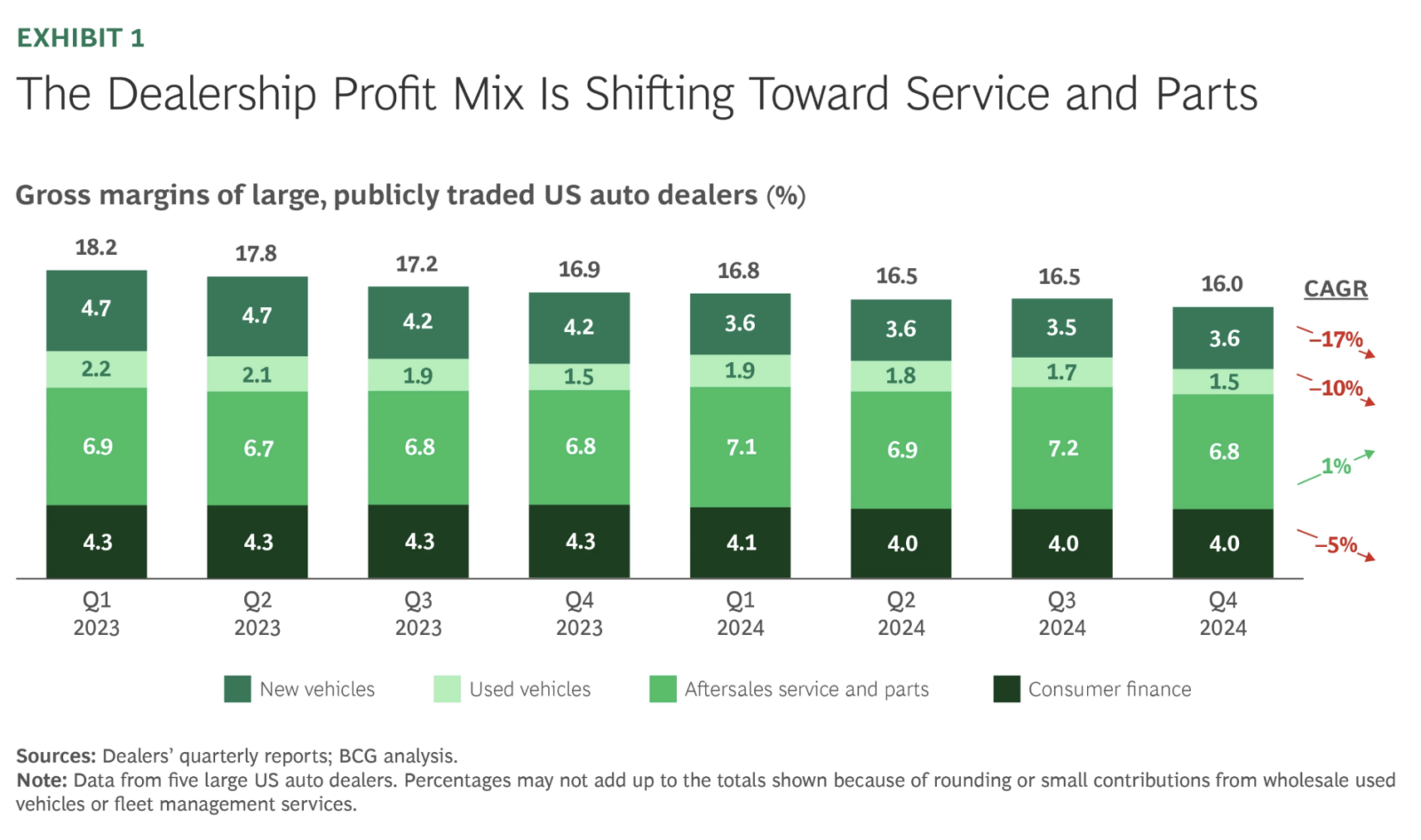 Anyone who’s been in the car business for a decent amount of time knows that the business is filled with uncertainty. It’s basically a masterclass in controlled chaos. But even by these standards, these new tariff threats feel like someone shook the Etch-A-Sketch we’ve all been trying to draw a stable business on. It’s enough to make even the most zen-like person feel a little twitchy.
Anyone who’s been in the car business for a decent amount of time knows that the business is filled with uncertainty. It’s basically a masterclass in controlled chaos. But even by these standards, these new tariff threats feel like someone shook the Etch-A-Sketch we’ve all been trying to draw a stable business on. It’s enough to make even the most zen-like person feel a little twitchy.
As a former dealership CFO and current on-demand fire extinguisher (a.k.a. CFO), I’ve ridden out more than a few storms. And I’ve learned this: when the unknown feels especially loud and apocalyptic, the smartest thing you can do is return to what you actually know. Like the basics. The stuff that works. The kind of practices that don’t require a crystal ball or a government press release to function.
Like most folks in the business, I’ve spent the last week glued to the news, muttering at my laptop like it’s the DMS that just froze mid-deal. But instead of yelling, I decided to write down a few things dealers can do right now to avoid disaster—or at least feel a little less like they’re free-falling through the financial stratosphere.
Because when the world starts spinning, the only thing that keeps you grounded is muscle memory. Steady habits. Daily disciplines. The not-so-sexy routines that end up saving your bacon. I’ve grouped these into three key categories—because nothing calms the nerves like a good, old-fashioned list.
1. Fixed Ops
Steady Habit: Fixed Ops Absorption
The Fixed Absorption Rate is a critical KPI for car dealerships because it measures how much of your dealership’s overhead is covered by the gross profit from fixed operations, which is service, parts, and body shop activities.
- Formula: (Fixed Operations [Service, Parts, Body Shop] Gross Profit / Total Dealership Overhead Expenses [excluding Variable Selling Expense]) x 100.
Examples:- Fixed absorption for Ford dealers: the sum of total parts, service, and body shop gross profit divided by the sum of total overhead expenses plus dealer’s salary, plus parts, mechanical, and body shop sales expenses.
- For Toyota dealers: gross profit from service, parts, and body shop divided by unabsorbed expenses minus new and used sales compensation, supervision compensation and F&I commissions.
- Why It Matters: Ideally, you want your fixed absorption rate to be as close to 100% as possible. Most experts agree that an absorption rate below 50% is poor and an absorption rate of 75%+ is excellent. A high absorption rate indicates that fixed operations are generating enough profit to cover the dealership’s overhead costs, reducing your reliance on vehicle sales to cover expenses.
If your fixed absorption rate is low, it’s likely time to look into increasing service appointments, selling more parts, or boosting customer loyalty through service incentives.
Benchmark: 75% – 100%
Why the Percentage Matters: A fixed absorption rate close to or above 100% means that your dealership’s service, parts, and other fixed operations are covering overhead costs, reducing dependence on vehicle sales for profitability.
Steady Habit: Take the “How you fix the car influences how you sell the car” approach

The trend outlined above will come as a surprise to precisely zero of the ~18,000 new-car dealers in the USA. – Glenn Mercer, Car Charts
We sell the car not for the margin it earns, but for the profit on the trade-in it brings, the financing it requires, and the service revenue it will eventually generate (both warranty and customer-pay).
But there’s another reason to create a steady habit of paying closer attention to service/fixed ops. It’s because service doesn’t just support the business; it drives it. How a customer feels in the service lane—respected, ignored, overcharged—has a big impact on whether they’ll buy their next car from you or walk across the street to someone else.
2. Used Cars
If you’ve already got a steady habit of superior used car inventory management, you are miles ahead of the dealer down the street. If used car inventory management hasn’t been the focus lately (for whatever reason) now is a good time to start.
A strong focus on used car inventory can will cushion the blow from potential Trump-era tariffs. By taking a strategic approach that aligns with shifting market conditions and consumer behavior, dealerships stay ahead.
Two critical areas to concentrate on are enhancing the quality of your inventory and managing it more efficiently.
Steady Habit: Used Car Inventory Enhancement
I regularly see dealerships with bloated used car inventories. In most cases, it comes down to one of two things: someone’s not watching the right KPIs, or the used car manager isn’t up to the job. Either way, it leads to expensive mistakes that could’ve been avoided.
Increase Used Vehicle Inventory
- Diversify Inventory Mix
- Broaden Price Points: Stock a mix of affordable used cars and higher-end models to cater to a wider range of buyers who may be priced out of the new car market due to tariffs.
- Emphasize Core Models: Late-model used vehicles (1-3 years old) are less affected by tariffs and (right now) offer a cost-effective alternative to new cars, which will likely see significant price hikes due to the tariffs.
- Expand Trade-In and Buyback Programs
- Source Locally: Dealers can replenish their used inventory by offering competitive trade-in values and buyback campaigns targeting local customers. This approach ensures a steady supply of high-demand vehicles without relying on imports.
- Leverage Service Customers: Target customers visiting for maintenance or repairs, as they may be more inclined to trade in their vehicles for newer options.
Steady Habit: Used Car Inventory Management
The National Automobile Dealers Association (NADA) provides several guidelines and best practices for managing used car inventory effectively to maximize profitability and operational efficiency. Below are the key principles based on NADA insights:
- Inventory Turnover and Aging
- Turn Time: NADA emphasizes that vehicles should ideally be sold within 30 days to maximize profitability. After this period, holding costs such as depreciation and maintenance start eroding profit margins. Beyond 90 days, vehicles become liabilities.
- Aging Metrics: Dealerships should monitor how long each vehicle remains in inventory. Older vehicles generally require aggressive pricing strategies to ensure they are sold quickly. They are also a strain on cash so selling them to make room for more attractive units is a best practice.
- Days Supply
- NADA recommends maintaining a 30-day supply of used vehicles, equivalent to 12 inventory turns per year. This ensures a balance between having enough stock to meet customer demand and avoiding overstocking, which can lead to excessive carrying costs.
- Reconditioning Time
- Efficient reconditioning processes are critical for reducing the time it takes to prepare vehicles for sale. Faster reconditioning improves inventory turnover rates and profitability.
- Performing recon in your service dept. is ideal for cash flow and keeps every revenue dollar in-house.
- Pricing and Appraisal Strategies
- Accurate appraisals are crucial when acquiring trade-ins or purchasing vehicles at auction. Only managers with a proven track record should be doing the appraising.
- Dynamic pricing strategies should be employed to adjust vehicle prices based on market demand and aging inventory.
- Customer Demand Analysis
- Understanding customer preferences through historical sales data and market trends helps dealerships stock vehicles that align with current demand, reducing the risk of overstocking or understocking.
3. Customer Loyalty
Have you looked around lately? I mean really looked—past the bumper stickers and into the furrowed brows of the guy at the gas station or the woman stress-scrolling outside the grocery store. Everyone’s worried. About what, exactly? Tariffs? Elections? The price of eggs? Take your pick. The only certainty seems to be that the uncertainty will stick around like a bad haircut.
And when people feel uncertain, they stop buying. They clutch their wallets like life vests and wait for someone else to blink first.
But here’s the thing—what cuts through all that ambient dread isn’t a flashy ad campaign or some desperate markdown. It’s trust. That old-fashioned, not-very-glamorous thing built between a customer and their dealer. The solid kind of bond that says, “I’ve got you,” even when the rest of the world feels like it’s about to tip over.
Steady Habit: Create customer loyalty by building customer relationships.
If there’s one thing that matters most in day-to-day automotive retail right now, it’s building real customer relationships. Not surface-level smiles or scripted follow-ups—genuine connection. And that kind of trust doesn’t come from a checklist; it has to be baked into the culture of the store.
As a colleague was gathering data recently, they noticed an “invisible customer” pattern happening and it’s illustrated best if I tell you the quick story:
A customer, let’s call him Mr. Miller, experiences a car breakdown and calls the dealership to schedule a service. He explains in great detail the symptoms his car exhibited before it stopped working. After a detailed 3-minute explanation, the store employee responds with a curt, “Hold, please,” and transfers him to a queue where he waits for several minutes. This response is not only frustrating but also dismissive of Mr. Miller’s immediate concerns.
A Service Advisor finally picks up. Mr. Miller again shares details of his car’s demise and even though he is clearly concerned and probably just needs someone to listen and understand, the service advisor says, “Last name?”
Don’t let your team create invisible customers.
Steady Habit: Create lasting impressions
If you can manage to create a dealership culture that genuinely puts the customer first – not just in a “we say that in all of our ads” kind of way, but in a way that shows up in how people actually behave – then congratulations: you just might have a customer for life.
This involves more than free coffee and remembering someone’s name. It’s about using the data you already have to actually make things easier, not creepier. It’s about personalizing the experience without turning it into a therapy session. And ideally, it’s backed by processes that make sense to people other than the person who wrote them.
In a world where people can get groceries, therapy, and probably a kidney delivered to their doorstep, delivering a truly memorable customer experience at a dealership is one of the last remaining magic tricks. Do it right, and you’re not just selling a car—you’re building a reputation. One that sticks around long after the new car smell dissipates.
Like this post? Subscribe to the Kruse Control Newsletter. Get more cutting-edge insights, exclusive content, and a dash of humor delivered weekly to your inbox!
